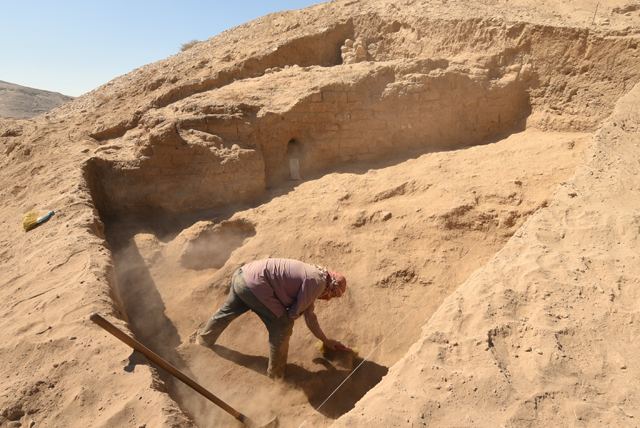You are here
Jamaan: Revealing Ammon’s Iron Age Defence, Assyrian influence
By Saeb Rawashdeh - Aug 19,2024 - Last updated at Aug 19,2024

Sargon II (right), illustration of a relief from the palace at Dur Sharrukin , Iraq (Photo courtesy of Britannica)
AMMAN — The site of Jamaan is located in the Zarqa Governorate, approximately 16 kilometres north of Amman. During the Iron Age II, the region of Upper and Middle Wadi Zarqa (biblical Jabbok) and its tributaries was the centre of the Ammonite kingdom.
Neo-Assyrian texts from the reign of Shalmaneser III (858-824 BC) reference Ammon as a significant place in regional politics. King Ba’asa of Amman participated in the coalition led by the king of Soba/Damascus against the invading Neo-Assyrians army at the battle of Qarqar on the Orontes in 853 BC.
The earliest document on the Ammonite kingdom was found in Jebel Qala (Amman Citadel), which mentions Milkm, the supreme deity of Ammon. Series of inscriptions and statues provide evidence of Ammonite kings and the deities that the Ammonites worshipped.
"The document mentions the second half of the 8th century BC, when Ammonite king Sanibu paid tribute to Tiglath-Pileser III (744-727 BC), Zakir and his son Yerah-azar to Sargon II (721-705BC), Pudu-Ilu to Sennacherib (704-681 BC) and Esarhaddon (680-669 BC), and Amminadab I to Ashurbanipal (668-631 BC), who also campaigned in the country during his war against the Arabs.
Ammon remained a vassal kingdom of Assyria also during the reigns of Ashurbanipal’s successors between c. 630 and 610 BC, with the king Ḥiṣṣal’el, and, successively, Ammi-nadab II both known from the inscription on Tell es-Siranbottle," highlighted the scholar Lorenzo Nigro from Sapienza University of Rome.
Following the Assyrian defeat at Kharran in 610 BC, and the accession to the throne of Nebuchadnezzar II (604-562 BC), Ammon fell under Neo-Babylonian control, Nigro said, adding that the dynasty of Amminadab I apparently held the power, with his grandson ‘Amminadab II, who reigned between c. 610 and 590 BC, and his successors Ḥanan’el and Ba’alys, who possibly was a contemporary of Gedaliah of Judah.
"During the reigns of all these kings, Bît-Ammani remained a vassal kingdom of Assyrians, and after the advent of Nebuchadnezzar II, of Babylonians. In the meanwhile, Jamaan was one of the defensive strongholds of the kingdom. Its final destruction, marked by a fierce conflagration and by the abandonment of the tower occurred towards the mid of the 6th century BC, apparently when the Persians took the place of Babylonians in ruling over the country, transforming Ammon into a province of their empire," Nigro underscored.
The stronghold of Jamaan consisted of a rectangular enclosure, with its longest western side overlooking the Pass of Bi’rein, including a raised podium which occupied its southwestern corner, and a main entrance on the northern short side. The fortress was defended by a double perimeter wall with casemates (21) in between. Structures were built with roughly cut limestone and quartz boulders of average dimensions (0.7-0.8 ⨯ 0.4-0.5 metres), usually laid in two rows of superimposed courses tied up with mortar, pebbles and small stone chops, Nigro explained, adding that the interior of the walls was also filled up with medium size irregular stones.
"The typology of the buildings is well known in Iron Age II in Southern Levant, and it has been labelled ‘citadel’ even though this term describes palatial complexes and fortresses, which often exhibit strong dimensional variations. In this case, the overall area occupied by the stronghold was about 1.5 dunams. Nonetheless, Jamaan, for its extension and plan, may be also compared with a fortified caravansary or a small castle," noted Nigro, adding that it may be reasonably included among the list of fortified sites overlooking the “House of Ammon”.
Regarding pottery, all pottery and finds are processed and thoroughly studied, Nigro said, adding that the selection focused on destruction layers inside the tower, where pottery and finds were collected in its latest layers of use.
"Table Ware includes mostly vessels coated with a dark brownish Red Slip, sometimes roughly burnished with a wooden tool. A plate [saucer] of coastal tradition was found, 37 coated with a highly burnished Red Slip, as like as some carinated bowls with emboldened or expanded rim. These are among the most common open shapes in late Iron IIC [c. 680-580 BC] Ammonite contexts," Nigro underlined.
Dipper jugs and juglets are also coated with a thick brownish slip 39 cooking jugs, pots, 40 crater, 41 storage jars and pithoi fit well in the late Iron IIC ceramic horizon of Ammon, and may reflect some Neo-Assyrian influx depending on the style of so-called Palace Ware.
"The fortress included a watching tower and an enclosure, perhaps used also for administrative purposes connected to caravan trade, and for the pass control. The stronghold material culture shares many aspects of so-called ‘Ammonite’ horizon - known from excavations in Jabel Amman, and in other kindred sites," Nigro elaborated, adding that the retrieval of the broken head of a small statue is coherent with this picture, as the Kingdom of Ammon is characterised in its main centres by the presence of such pieces of statuary," Nigro outlined, adding that nonetheless, its style may indicate a late Neo-Assyrian influx, as it reminds some Arab personages in Ashurbanipal’s reliefs of the North Palace in Niniveh.
Moreover, the finding of a duck-weight also points to this direction. All these elements testify to the nowadays unfortunately disappeared fortress being part of the defensive and administrative system of the Kingdom of Ammon also during the Neo-Assyrian and Neo-Babylonian domination.
Related Articles
AMMAN — Amman and its surroundings were a main centre of the Ammonite Kingdom and some of their structures can be found on the Amman Citadel
AMMAN — Rabbot-Ammon, literally “the Great [City] of Ammon”, was the capital of the Iron Age kingdom of Ammon, said a German archaeologist d
AMMAN — Tell Bleibil is a site located in the southern Jordan Valley, where a team of German archaeologists has been excavating for years.














